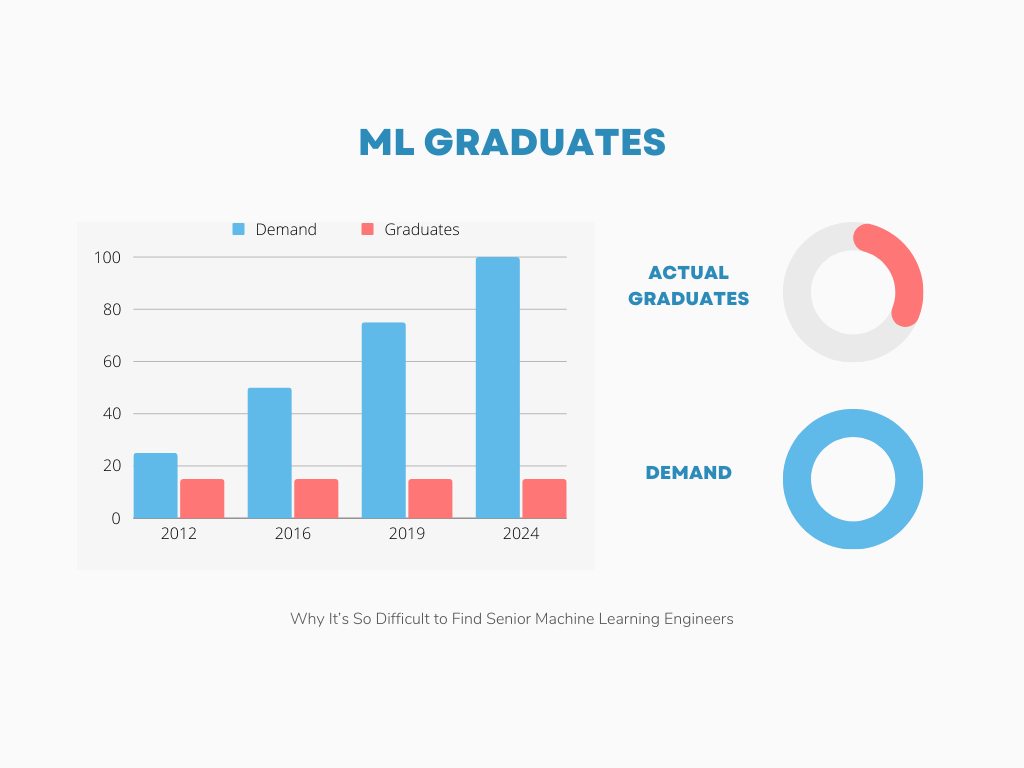Undoubtedly, 2023 was the year of AI - AI went mainstream, the number of AI companies exploded, as did funding for and investments in AI companies.
It was also the year that the number of machine learning engineer jobs went through the roof compared to previous years.
It’s not just interest in ML jobs that has grown, but the actual number itself has exploded.
LinkedIn listed AI Engineer as one of the Top 10 Fastest Growing Roles for 2024 in a recent article this month.
Georgetown's Center for Security and Emerging Technology just released a data analysis that AI developer/engineer jobs increased by 25.8% from 2018 to 2022, surpassing 5 million jobs.
The growth of the number of jobs has made it very difficult to hire - and it’s not just that technologies such as OpenAI, Mistral AI, Bard and other models with APIs are so new.
Companies want Senior Machine Learning engineers, not mid-level, junior, or entry-level.
So why is it so hard to hire a Senior Machine Learning Engineer?
Let’s take a quick look to find out.
Senior Machine Learning Engineer Job Growth and Requirements
A quick search on Indeed for ‘machine learning engineer’ gives 15K results across the United States - this is up significantly from the 5K not 18 months ago. So the sheer number of open jobs at any given moment has almost tripled.
This matches the 1.2 million job increase in AI developer/engineer jobs that Georgetown's analysis uncovered.
Most of these are for Senior Machine Learning Engineer roles - perhaps a result of the pandemic, but more likely a desire on the part of companies to build and deliver ML products quickly, which generally means hiring more experienced talent for their efficiency.
Senior engineer roles generally require 5-8 years of experience.
To Have Senior Engineers Now, We Needed Entry-level Machine Learning Engineer Jobs 5 Years Ago (There Weren’t)
Given the years of experience requirement, this means that 5-8 years ago, the Senior Engineering talent pool of today had to have been getting jobs in Machine Learning. But not just any jobs - entry-level jobs.
Entry-level jobs in machine learning 5-8 years ago didn’t exist in the numbers that are required to match today’s talent demands. There weren’t 15K open entry-level machine learning roles for fresh graduates to go into.
.png?width=712&height=534&name=ML%20Graduates%20Graph%20(1).png)
So if there were only 5K machine learning jobs 5 years ago, it means today there are only 5K senior machine learning engineers on the market.
8 Years Ago, We Needed Enough Machine Learning or CompSci Graduates (There Weren’t)
In order for us to enough Machine Learning talent to fill today’s jobs, it means that 5-8 years ago, there had to be enough graduates annually with a Master’s of AI/ML or Master’s of Computer Science with a specialization in AI/ML, or a Bachelor’s of Computer Science with a focus on AI/ML.
There are around 65K computer science graduates annually today, and that number has been relatively consistent over the last decade. Universities struggle to grow their Computer Science offerings because they can’t hire enough professors - if you have such skills, why teach when you could get 3-6x the salary in industry? This problem has plagued universities for more than a decade, and, to no surprise, continues to do so.

There definitely weren’t 15K graduates with a Master’s in AI 8 years ago - universities didn’t have the capacity - and most CS grads weren’t hyped about AI/ML. Deep learning had only just begun to take a grip, and was largely reserved for Master’s specializations.
So if there were only 3K graduates 8 years ago, it means today there’s only 3K senior machine learning engineers available in the talent pool.
To Have Graduates, High Schoolers Needed to Be Interested in CompSci 12 Years Ago
Since universities were struggling to hire CompSci professors for the last decade and more, most universities and colleges had limited spaces for Computer Science classes and graduates. This meant getting into CompSci degrees were highly competitive. Universities couldn’t keep up with demand (and still can’t).
With programs being so competitive, candidates with any hopes of being admitted had to have excellent high school grades in mathematics, statistics, IT, and other related subjects.
It also means that high schoolers had to have selected the right classes 12 years ago in order to get into a CS program.
12 years ago, the Google Brain team (led by Andrew Ng and Jeff Dean) had only just created a neural network that could recognize cats by watching unlabeled images taken from frames of YouTube videos. It was a great accomplishment - but not one that inspired thousands of high schoolers to pursue STEM classes to go on to a Computer Science major.

Getting Into High School Classes Required Middle School Requirements 16 Years Ago
Being able to take certain STEM classes in high school requires prerequisites that are often completed in middle school. Of course, middle schoolers aren’t thinking about how they’re going to become a Senior Machine Learning Engineer 16 years later, so if they didn’t have access to learning planning, or an interest in STEM, then there’s little chance they’d set the foundations that would enable them to pursue ML later on in life.
It sounds crazy to think that talent shortages now stem from things that didn’t happen 16 years ago, but this is how the US education system is structured.
What’s also crazy is to think that today, those in middle school need to be exposed and inspired by STEM now so that they can get into high school classes to then go on to college and get a CompSci degree and head into Machine Learning.
STEM Education Is and Was Not Equally Distributed
There’s an enormous body of research around STEM education, and particularly how it is not accessible for every child in America. This means there are physical limits at an early age of who becomes interested in STEM, who has access to STEM courses and particularly to Computer Science courses in middle and high school, and who has completed the required classes upon graduating high school to get into Computer Science degrees in college.
This is important to consider given the need to increase diversity in tech, and very specifically in machine learning.

So Why Can’t You Find Enough Senior Machine Learning Talent? It Doesn’t Exist.
Senior Machine Learning Engineers aren’t a myth, but they are severely limited in number, largely due to limits on engineering jobs 5 years ago, the limits on the number of graduates annually, and who got into computer science degrees following middle and high school.
The machine learning talent in demand today simply doesn’t exist at the scale companies want it to, which means companies compete for a small talent pool and pay inflated salaries.
Some companies offer $300-600K salary, so if you’re not in that range, you’ll find it hard to get the talent you want.
Smart companies will recognize that the desired talent pool physically doesn’t exist, and will develop a different talent strategy for machine learning talent.
.png?width=1024&height=768&name=ML%20Graduates%20Graph%20(2).png)
Next Best Solution: Invest and Train Near-Neighbor Talent
There might not be enough Senior Machine Learning Engineering talent, but there’s a huge talent pool of ‘near neighbor’ talent. By near neighbor talent, we mean talent that has a similar skill set to those of machine learning engineers, but are missing a specific list of skills.
For example, a software engineer has a whole suite of skills and experience that are still highly valuable, but they may lack specific comprehension of machine learning algorithms, techniques, etc. They are highly likely though to be able to learn such skills quickly. This means with a small training period, you can have a close-to-senior machine learning engineer in less time than it would take to find new machine learning talent.
Further, this approach breeds retention, loyalty, and means that in a couple of years, you’ll have a great pool of homegrown senior machine learning talent.
Companies that understand this will invest accordingly, because the competition for ML talent is only going to get worse as the AI race heats up, VC money continues to pour in, and universities fail to meet growing demand due to their inability to hire professors and grow classes.


